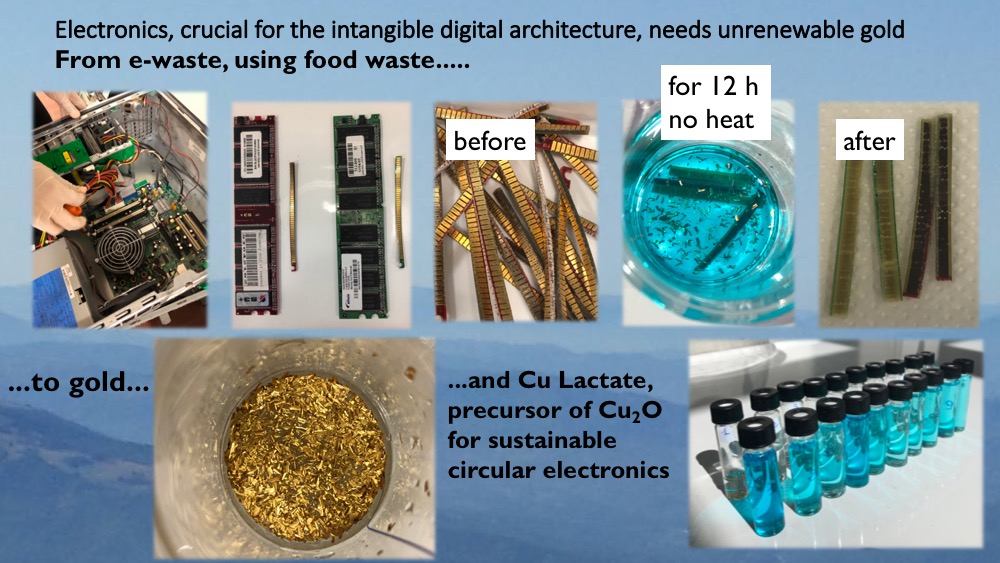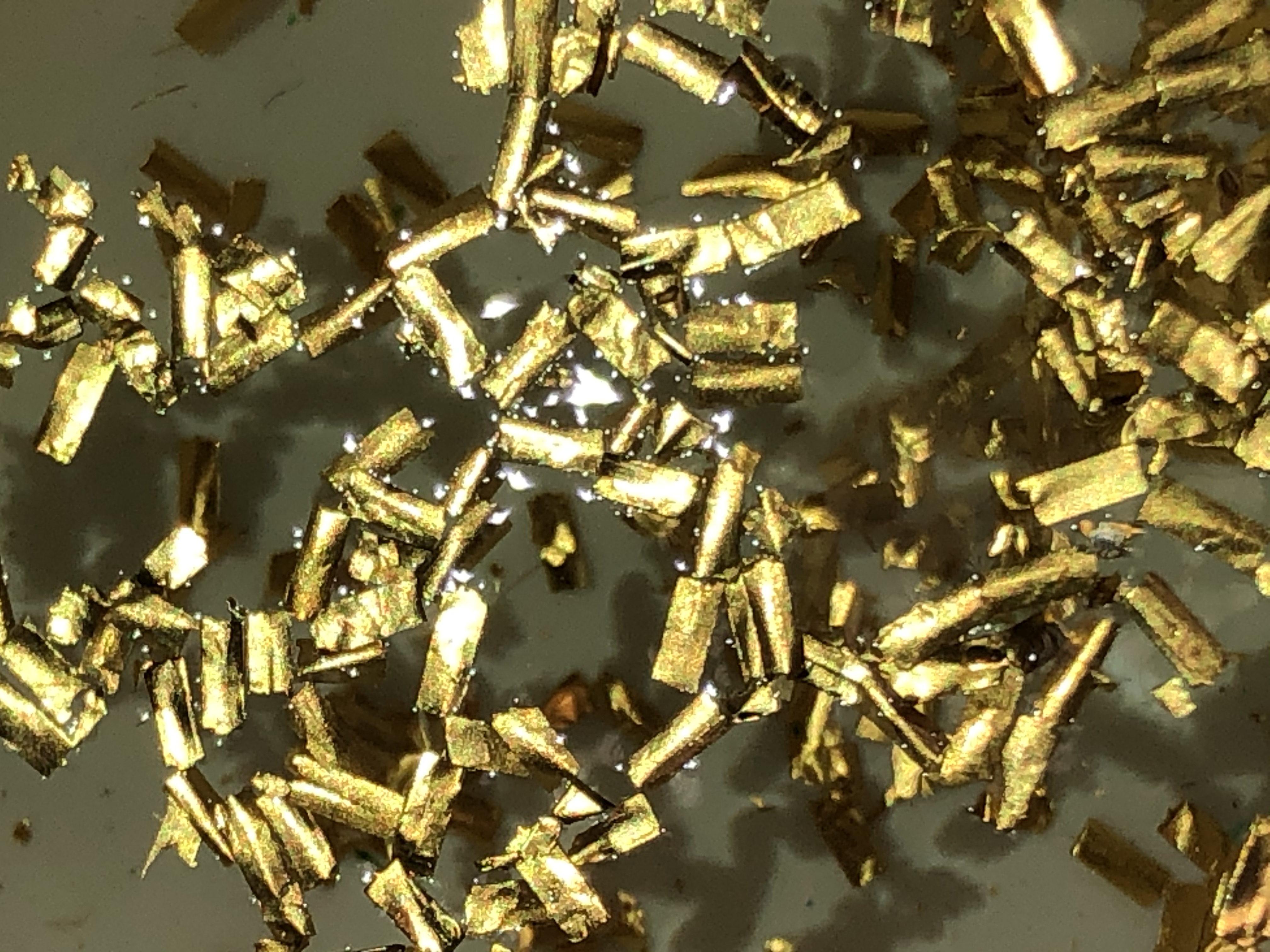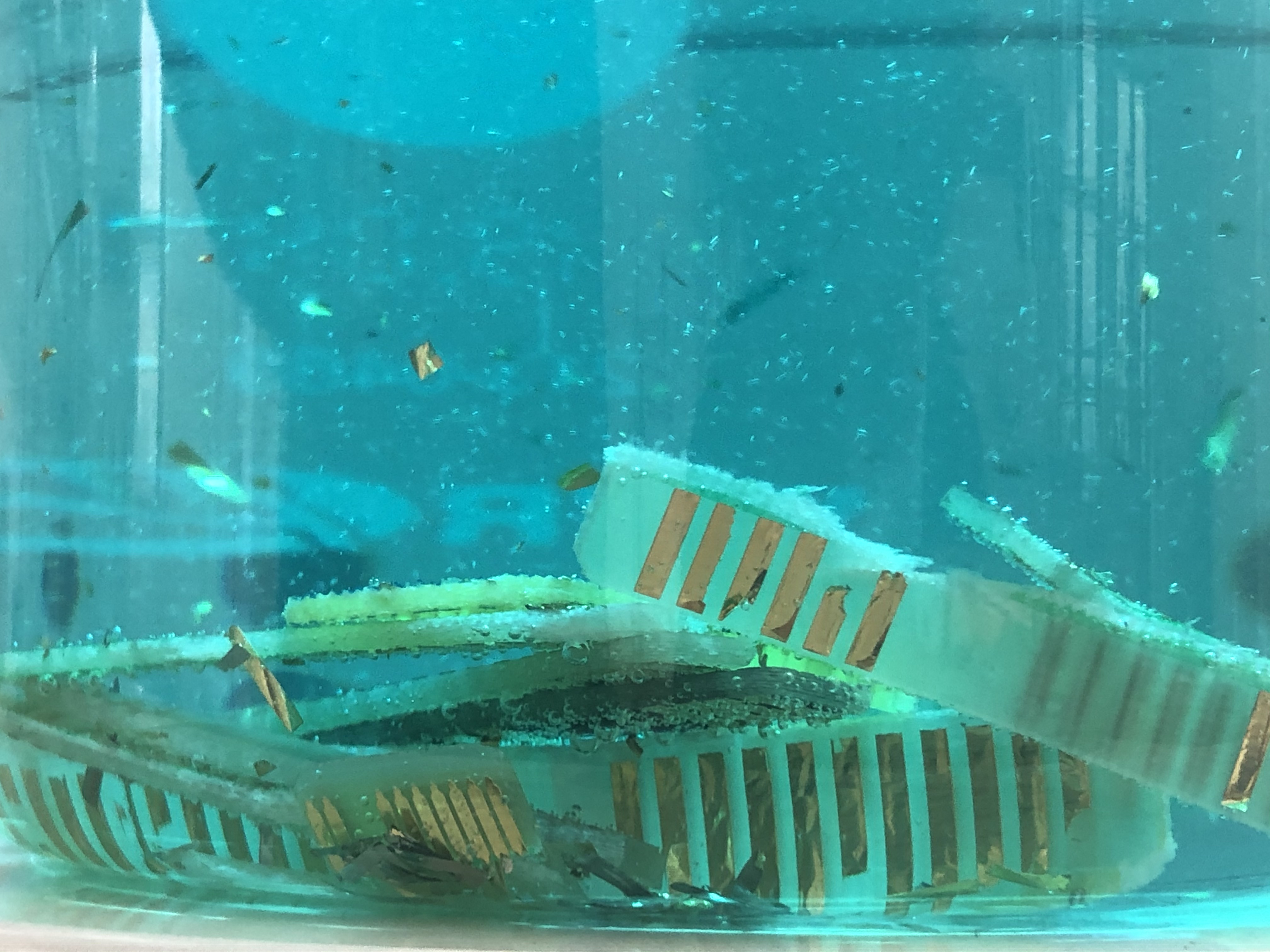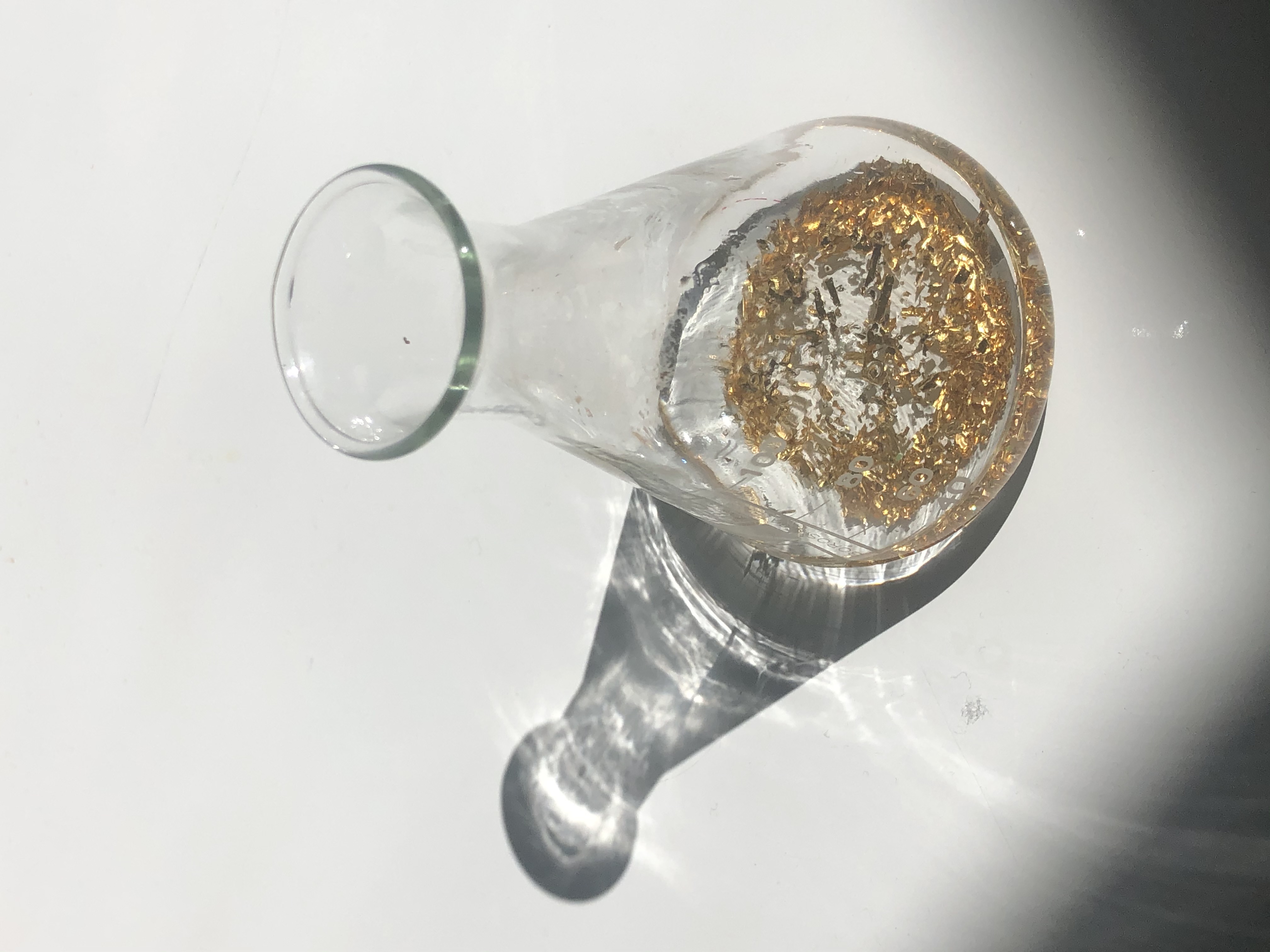Electronics, crucial for the intangible digital architecture, needs unrenewable gold. Gold is profitably peeled from e-waste by an oxidant and food waste acid. This sustainable room temperature strategy provides pristine gold, perfect for circular electronics and the precursor of a precious photocatalyst. Inspired by green chemistry (zero waste/renewable and safer reagents/no solvents/energy efficiency/closed loops) this education initiative enables a fair, fine industrial scaleup and employment
Gold is peeled from e-waste via base metals oxidation by hydrogen peroxide with lactic acid from food waste. This sustainable room temperature eco-designed strategy provides pristine gold, ideal for circular electronics, and copper lactate, as a by-product, ideal for producing cuprous oxide, a precious photocatalyst.
The project (started as an education initiative):
- revolutionizes the standard approach to gold recovery that is still the chemically redundant, harsh, hazardous, and energy-intensive alchemic strategy
- is inspired by green chemistry (zero waste, less hazardous reagents, no solvents, energy efficiency, renewable feedstocks, safer chemistry, closed loops via upcycling of both gold and by-product)
- guarantees profit, employment, inclusion: 78.0% of 53.5 MMt of e-waste in 2020 is uncollected with a wasted metal value of $57 billion
- prevents marginalized populations from being exposed to severe health risks from (i) illegal e-waste processing via hazardous procedures (ii) gold mining
- prevents the depredation of unrenewable and unsecured gold
- meets the SDGs of Agenda 2030 (health, quality education, work, innovation, responsible consumption and production, environmental consciousness)
- enables a paradigm shift from linear to circular electronics crucial for digitalization
- disseminates its results
- to scientists and stakeholders via scientific international congresses and publications without patent-related barriers
- to the general public via Scientific Theater STEAM performance on prestigious stages: gold is a symbol of preciousness and beauty; we retrieve its symbolism from classical masterpieces to valorize the aesthetics of gold peeling from e-waste and raises consciousness about sustainable production and consumption in humanistic environments impenetrable to the scientific culture
- to secondary students via research-oriented didactic paths and primary students via scientific edutainment games
Please highlight how the project can be exemplary in this context
Electronics needs gold to cover electrical contacts and avoid oxidation. The massive demand for smarter electronic devices triggers a mounting shortage of raw materials. 78.0% of the impressive quantity of e-waste generated in 2020 (53.5 MMt) is uncollected, and the same percentage of gold is wasted. A paradigm shift from linear to circular electronics is needed to promote sustainability and maintain electronic device production at a certain level indefinitely. The project is exemplary because it develops a circular and logical approach to the gold recovery from e-waste: it is based on the three pillars of sustainability, mentioned by the triple bottom line: planet, people, profit:
• Planet: gold is one of the most unsecured metals. It is an unrenewable resource (https://doi.org/10.1016/j.wasman.2016.11.018). There is 100 times more gold in a ton of mobile phones than in a ton of gold ore. Hence e-waste collection and gold upcycling are mandatory. A net saving of CO2 is due to urban gold mining substituted to gold mining. The energy-efficient strategy of the proposed method does not require heat. For these reasons, the project can reduce the ecological footprint of the electronics business
• People: e-waste is illegally exported to developing countries for open burning or uncontrolled acid leaching, or it is landfilled and stockpiled; this endangers marginalized populations to serious health risks. The project enables equity, fair labour, education, health, inclusion, respect for human rights; people need technology, but technology needs unrenewable raw materials that must be properly upcycled from e-waste: this is the aim of the project
• Profit: the project enables a stable stream of gold (by a “cradle to cradle” approach to e-waste) to maintain production and profit at a certain level: gold (ca. 350 g/t of gold for mobile phone) is the paying metal, and its recovery triggers that of potentially scarce special metals, keeping the process worthwhile.
Please highlight how the project can be exemplary in this context
Gold has always been the symbol of beauty and preciousness. The project is exemplary because its vision is inspired by art and culture: we all know they gratify and stir human minds. Our project creates well-being thanks to its
- enabling the maintenance of technology output, crucial for the intangible digital architecture of a facilitated lifestyle
- simple aesthetic enjoyment, like other cultural languages. It is well known that the aesthetics of an experiment improve learning and creativity. The results described in this application originate from myriads scientific experiments: every experiment is a question for Nature; its answer is a masterpiece for the grace, harmony, beauty, emotion, and sense of wonder it generates during its aesthetic enjoyment. Creativity is where the artist and the scientist can meet on the street paved with beauty when deliberate disobedience to codified practices proves they are not the best and new ideas breakthrough. The joy of observing a phenomenon and the mathematical interpretation of raw experimental results create a profound emotion and the sense of mystery that is the seed of every art and science.
Based on our Vision, the aesthetics and quality of experience beyond functionality have been treated in detail because they are as important as the scientific content for its dissemination. In the technical mission (to recover gold from e-waste), the need for contamination between technical and artistic languages came easy. Art and technique seem to belong to antithetical categories. In ancient Greek, "techne" really means "art". Both require creative intuition, talent, and dedication, non-dichotomous qualities of technicians and artists. In this scenario, we realized Scientific Theater STEAM performances on special stages and edutainment games for the general public and students (described below), respectively, for the guided hands-on discovery of the best practice to recover gold from e-waste, inspired by classical masterpieces
Please highlight how the project can be exemplary in this context
The research-teaching link and my attempt to be clear with the students regarding the best e-waste processing practices prompted my idea. Schools should produce and not only reproduce knowledge to promote true public participation of students as citizens of the world.
The project is exemplary because
- Provides Inclusion
- via the didactic path: it exposed students (girls in particular) to the pleasure of multidisciplinary STEM discovery on a multicultural theme (marginalized populations are exposed to severe health risks by illegal e-waste processing), encouraging dialogue across cultures. Due to pandemic restrictions, all activities were done during a distant teaching course; I was in the lab. Equal opportunities were promoted via the absence of stereotypes, equal access to classes (laptops provided to students needing them), a variety of learning, teaching and assessment styles, all-inclusive respectful culture with clear rules, challenging negative attitudes.
- turning the e-waste crisis into inclusive employment: women make up just 14.9% of gold miners: this green gold recovery from e-waste remedies this historical gender imbalance and outdated social attitude, resolves barriers to fair labour independently of gender, ages, culture
- avoiding patent-related barriers and promoting both scientific and cultural dissemination (see details below) to improve public participation, citizen engagement
- enabling a sustainable digital architecture of built environment to increase
- accessibility: locations reached more easily, technology removes urbanistic gender gap and architectonic barriers
- affordability: the profitability of this waste-to-profit strategy (i) fosters the socio-economic empowerment that in turn avoids poverty, (ii) makes its industrial scale-up affordable
- via co-design, universal design: disabled people were involved by ECOAMA in e-waste disassembly. Technology is crucial for them to facilitate life, improve connectivity
Please highlight how this approach can be exemplary
As we move towards a new era of digitalisation with increased dependency on electronic devices and connectivity, we change how we live and interact with the built environment. To maintain our lifestyle at a certain level indefinitely, that is to make it make sustainable, stakeholders and the civil society should focus, respectively, on responsible production and consumption, shifting from a "take/make/waste" to "take/make/reuse" paradigm in electronics because key chemical elements, crucial for technology (especially gold), are unrenewable and unsecured resources.
The project arising from teaching is exemplary because it links three inseparable core values
- sustainability: it develops a technological idea that embraces principles of circular economy (zero waste, preservation of unrenewable resources), EUGreenDeal (climate, energy, building, industry innovation), green chemistry (zero waste, less hazardous reagents, no solvents, energy efficiency, renewable feedstocks, safer chemistry, closed loops via upcycling of both gold and by-product), Agenda 2030 SDGs, bringing long-term, life-cycle thinking in the industrial ecosystem responsible for the digital architecture of our built environments
- aesthetics: it merges the artistic and scientific languages to disseminate the project idea and shape correct behaviour at all levels of society (students, general public), including responsible production and consumption of electronic devices that underpin our built environment, make our lives better, replace humans in hard works thereby providing extra-time for cultural needs
- inclusion: the proposed circular digital architecture (i) has roots in STEM education (i) engages the civil society at large (ii) brings decent work and economic growth, remedying historical gender gap in gold mining (iii) enables improved quality of life in terms of housing accessibility and affordability and social inclusion valorising diversity, equality for all (disables in particular)
The need for long-term, life-cycle thinking in the industrial ecosystem stimulated the idea and paved the way to its realisation. The impact of the project is witnessed by the fact that the global scientific community considers the approach at an advanced stage of technology and socially affordable. Prof. Clara Santato (PI of Collaborative Research and Training Experience in Sustainable Electronics and Eco-Design project, holder of a Canada Research Chair in Sustainable Organic Electronics and a member of the UNESCO Materials and Technologies for Energy Conversion, Saving and Storage Chair) decided to valorise the pristine gold peeled off from e-waste via this green strategy within the framework of international projects, especially those focused on a "trash to treasure" approach in e-waste dumping sites (RECYCLE AFRICA).
Recovered gold was sent to Polytechnique Montréal where the research group led by Prof. Clara Santato (i) demonstrated via SEM, EDX, and XPS that the present strategy did not downcycle gold because it was only peeled off and not oxidised and then reduced to the metal state; (ii) prepared the first organic field-effect transistor with recycled gold metal contacts; electrical measurements demonstrated that recycled gold can profitably replace commercial gold.
The advanced collaborative research was shared with the international scientific community in the prestigious Fall meeting of the Material Research Society in Boston: Teresa Cecchi, Clara Santato, Christophe Clement, Zhaojing Gao Sustainable Gold Peeling from E-Waste via Food Waste Byproducts, Material Research Society Fall 2021. Boston 1st Dec 2021
Please also explain the benefits that derived from their involvement.
I teach chemistry at the Technical Institute Montani in Fermo, Italy. I have engaged students with my ideas and strategy to teach them sustainability practically. We dismantled 63 dismissed PCs. We asked many IT shops and IT professionals for e-waste, clearly explaining why we asked for e-waste. ECOAMA, a social cooperative of disabled people, was involved
I included this project in the formative offer of the school (PTOF document) to let citizens be aware of the ongoing project. An edutainment scientific bingo highlighted the e-waste problem and its possible smart solutions. My trained students (with the help of a video due to pandemic restrictions on on-site activities ) tutored the citizens. They explained the importance of the STEAM approach within an original humanistic framework: 2020 and 2021 marked the 500° and 700° anniversary of Raphael's and Dante's death. In the Aristotelic view that inspires both of them, gold is associated with the sun; hence we used their masterpieces to raise consciousness about gold upcycling and captivate that part of the civil society unfamiliar with science.
The online game, noteworthy during Christmas vacation, had ca. 5000 participants both in 2020 and in 2021.
According to our Vision (science aesthetics is crucial), I also ideated and coordinated two spectacles for the general public. The 1st, about The School of Athens (trailer, IT version), reflects on alchemy; the 2nd, about The Divine Comedy (extract), deals with alchemy (video pitch) and shows gold upcycling on a prestigious stage.
The benefit derived from the involvement of civil society is the increased awareness and consciousness of the e-waste problem: most people were completely ignorant about the fate of their devices and the treasure hidden in e-waste. Similarly, they did not know that there was more gold in their town than in a gold mine. The urban metallurgy must be sustainable to close the production loop in electronics, and that is the project aim.
Global challenges:
- The massive demand for smarter electronic devices with falling prices
- has flourished the quantity of e-waste throughout the world
- triggers a mounting shortage of raw materials and precious metals: gold is one of the most unsecured metals (https://doi.org/10.1016/j.wasman.2016.11.018), but it is crucial for electronics.
- Correct processing of e-waste within the framework of the Agenda 2030 is challenging because the end of life alternatives for e-waste are a pressing global issue: e-waste is often illegally exported to developing countries for open burning or uncontrolled acid leaching, or they are landfilled and stockpiled (https://doi.org/10.3390/ijerph16091595 ), and this
- endangers marginalized populations to serious health risks
- prevents the recovery of unrenewable resources, such as valuable metals, much more concentrated in e-waste than in their primary ore minerals (https://doi.org/10.1016/j.mtsust.2020.100040 )
- Recovery is mandatory to maintain the supply chains and reduce the carbon footprint of primary-mined gold thereby mitigating the environmental consequences of metal mining (https://doi.org/10.1007/BF03214988 ): recycled gold represents an important “green” source for this element.
- There is a colossal motivation for gold e-waste mining because gold is the “paying metal” and its recovery triggers that of potentially scarce special metals, which would otherwise not be cost-effective, thereby keeping recycling economically worthwhile.
- The main global challenge is to devise a chemically logical, cost-effective, environmentally friendly, and energy-efficient strategy to recover gold (e.g. ca. 350 g/t for mobile phone handsets) and other metals from e-waste: the project accepts the challenge by WEEE Directive (art. 8): the proposed strategy is the "best available technique" envisioned by the WEEE Directive.
- Need for energy efficiency in green chemistry: the strategy does not require heat
The WEEE Directive aims at e-waste processing according to the "best available technique". The two mainstream practices that process the small percentage (22% in 2020) of e-waste, not illegally exported or landfilled, date back to alchemy regarding the recovery of gold, usually plated over base metals to minimize resistance. In pyrometallurgical processes, the crushed gold-containing scraps are burned, and incineration, smelting, sintering, and melting occur: metal alloys and oils from plastics are produced along with a large amount of solid waste and very toxic emissions. The hydrometallurgical process makes use of (i) a strong oxidizer and leachants to dissolve gold and base metals (ii) a reductive step to reduce gold ions to the metal state selectively. The cyanide and aqua regia are employed; their toxicity and corrosiveness endanger the workers and the environment as demonstrated by environmental accidents at gold recovery facilities; wastewaters are a major problem of this treatment that is harsh because gold oxidation is arduous. Alternative oxidants and leachants were explored but this mainstream practice is illogical because (i) it is chemically redundant as it firstly oxidizes gold and subsequently reduces gold ions to metal gold; (ii) gold, recovered from the mixture, is downcycled compared to the original gold flakes in the e-waste.
The sustainable proposal described in this application eliminates both unnecessary steps: only base metals are oxidized and not gold! We do not have gold ions; hence we eliminate the reductive step! Gold is peeled off as solid flakes with the original purity. Since base metal oxidation is easy, it can be accomplished with acids recovered from food waste and a green oxidant such as hydrogen peroxide. The use of food waste to treat e-waste avoids crushing and chemical steps, reduces the loss and downcycling of gold, saves cost and time, and closes the loop because wastewaters contain the precursor of a photocatalyst.
Please provide clear documentation, communication of methodology and principles in this context.
Since I believe in shared knowledge, I did not patent this green procedure to recover gold from e-waste. The applicant illustrated the method in the prestigious Congress of the Material Research Society in Boston to transfer the project's results to all interested parties and contexts: Teresa Cecchi, Sustainable Gold Peeling from E-Waste via Food Waste Byproducts, Material Research Society Fall 2021. Boston, 1st Dec 2021. A publication in a prestigious peer-reviewed scientific journal will fully instruct interested parties for the industrial scale-up. The global e-waste recycling market was estimated at $3,854.5 million in 2020 (annual growth rate of 3.7%). Technology giants adopt sustainable production and supply chain practices as part of their vision, and governments play an instrumental role by framing policies (extended producer responsibility). Traditional methods of handling e-waste need to be replaced with advanced technologies such as robotics and IIoT. Still, the chemistry at the base of urban mineralogy needs to be optimized, which has been the aim of this project. There is potential to recover more than $57 billion worth of raw materials with effective management of e-waste. To date, the proposed strategy is the "best available technique" envisioned by the WEEE Directive (art 8).
DOCUMENTATION: Complete peeling of gold was obtained in 12 h using a mixture of lactic acid (6M) from food waste and hydrogen peroxide (6M) on RAM edges (5% w/v of the reagent solution) without heating. Gold flakes were separated via filtration, dried, and weighted. The recovered gold in the metal state was 0.630 g from 149.8864 g of RAM edges (0.42% yield relative to the mass of waste RAM edges). Filtrates were analyzed by ICP-AES: gold is absent; cupric lactate, the main constituent of the filtrate, is the perfect precursor of (i) copper nanoparticles; (ii) Cu2O, a green low-cost photocatalyst for water splitting and CO2 conversion.
Please note: The application concerns an existing COMPLETED example; the project is located in the EU; the file "BOSTON BAU.pdf" hereby attached ALSO includes FURTHER results obtained by the research group of Prof. Clara Santato on the gold (recovered from e-waste) I sent to Polytechnique Montréal, thereby witnessing the advanced stage of technology of this project.
The project is summarized in a 3 min video
Short Biography of TERESA CECCHI
Five-Years Degree in Chemistry, with marks 110/110 "cum laude" at the University of Camerino, Italy. PhD in Analytical Chemistry. CLIL Teacher, among the best 50 Teachers in Italy (teacher prize competition 2017). Researcher author of 2 books, 7 chapters in books and encyclopedias, 61 peer-reviewed papers in high impact factor international scientific journals, 33 communications in national and international conferences. She serves as Editor of the Journal of Liquid Chromatography and Related Techniques. She serves as a reviewer for many prestigious scientific journals. She is the organizer of edutainment activities such as Tombolone Scientifico, Scientific Art Exhibition, and Actors of Science. She ideated and realized 20 scientific-artistic performances for prestigious Science Festivals on exceptional stages and Theaters to disseminate research results within a STEAM framework. She is the coordinator of 18 projects awarded in national and international competitions. She is interested in the chemistry of bioplastics, nutraceuticals, green buildings, chromatography, the chemistry of interfaces, flavours, antioxidants, food waste, plastic waste, and e-waste upcycling. She was chosen as the Italian Delegate at Science on Stage Europe, Prague, 2022.





@ITT MONTANI, 2022
Content licensed to the European Union.